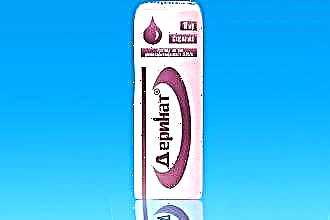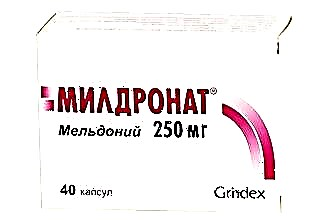When a person develops myocardial infarction, blood flow is disturbed in one or more of the coronary vessels. This leads to an imbalance between the oxygen demand of myocardiocytes and its supply. Changes in metabolism due to lack of nutrients exacerbate the condition of the affected tissue area. As a result, the cells of the heart muscle begin to necrotize and die off. At the site of the dead tissue, a scar is formed. In this article I want to talk about the mechanism and possible consequences of such a "replacement".
Development mechanism
At the time of the development of an acute infarction, there is a sharp violation of the blood supply in the myocardium for the following reasons:
- Rupture of an atherosclerotic plaque under the influence of a sharp jump in pressure, increased heart rate and intensification, accelerated blood flow through the coronary vessels.
- Blockage of blood vessels due to blood thickening (acceleration of platelet aggregation, activation of the coagulation system, decrease in the rate of blood clot lysis).
- Coronary artery spasm (vasoconstriction).
I often observed patients in whom several factors were determined at once as the cause of the onset of a disease with myocardial damage. In young patients, vasospasm is often the basis of pathological disorders, which cannot be determined after starting treatment.
Expert advice
I strongly recommend starting treatment in a hospital setting immediately after an acute attack, since only in this case it is possible to limit the further spread of necrosis and minimize irreversible changes in the myocardium.
The study of histological samples confirms the destruction of the myocyte of the heart 20 minutes after the development of ischemia. After 2-3 hours of lack of oxygen, glycogen stores are depleted in them, which marks their irreversible death. Replacement of myocardial cells with granulation tissue takes 1-2 months.
As my practice and the observations of colleagues show, the scar on the heart finally consolidates after six months from the moment the first symptoms of acute infarction appear and is a section of coarse collagen fibers.
Classification
Heart scars can be classified according to their location and extent.
They can be located along the coronary vessels:
- Violation of blood flow in the anterior interventricular artery leads to ischemia followed by the appearance of a scar in the septum between the ventricles with the involvement of the papillae and the lateral wall, as well as on the anterior surface and apex of the left ventricle.
- The inferior and lateral parts are affected when the left circumflex coronary artery is blocked.
- Problems with the myocardial blood supply in the right artery results in irreversible changes in the right ventricle and can affect the posterior-inferior part of the left and septum. But such a violation is extremely rare.
By the type of distribution, scars are local (focal), which can be compared with a scar on the body, or diffuse (multiple). Experts call the second option dystrophic changes in the myocardium.
How does a scar manifest itself?
The acute period of a heart attack is characterized by a variety of clinical manifestations. The main symptom is pain, which is relieved exclusively by narcotic analgesics and can be observed from an hour to 2-3 days. Then the pain syndrome disappears and the formation of a necrosis area begins, which takes another 2-3 days. Then comes the period of replacement of the affected area with loose fibers of connective tissue.
If the correct treatment tactics are applied, the following symptoms are noted:
- development of compensatory hypertrophy;
- the violation of the rhythm (which often accompanies the acute period) is eliminated;
- exercise tolerance gradually increases.
If a scar that occurs on the heart crosses the pathways along which the impulse travels, a conduction disturbance is recorded in the form of a complete or partial blockade.
In the case of successful recovery after a primary small-focal infarction, I did not notice any pronounced disorders associated with the work of the heart in my patients.
If patients have formed a large scar or many small ones, the following deviations are observed:
- dyspnea;
- increased heart rate;
- the appearance of edema;
- expansion of the left heart;
- pressure fluctuations.
How dangerous is it
The most dangerous is the development of a scar as a result of macrofocal or transmural infarctions, as well as several repeated violations in different basins of coronary vessels with diffuse multiple lesions.
In the case of a large lesion or widespread cardiosclerosis, the remaining healthy cells cannot fully compensate for the damaged cardiomyocytes. The frequency and strength of contractions increases in order to provide organs and tissues with oxygen and essential substances.
As a result, tachycardia develops, with its appearance the load on the heart becomes even greater, which leads to dilatation of the left ventricle and atrium. As the progression progresses, blood stagnation appears in the right sections with the development of heart failure.
I observed another complication: a scar on the heart after a heart attack with extensive and deep lesions of all layers of the organ caused the formation of an aneurysm due to the thinning of its wall.
The reasons for the appearance of such a defect are:
- transmural lesion;
- increased blood pressure;
- increased blood pressure inside the ventricle;
- excessive physical activity of the patient, refusal to comply with the regimen.
Aneurysm leads to the rapid development of heart failure, the formation of a parietal thrombus, pronounced stagnation in the systemic circulation. Often complicated by severe rhythm disturbances that can lead to death (paroxysmal tachycardia and ventricular fibrillation).
Diagnostics
In order to establish a diagnosis, I conduct a survey, study the history of the disease (mainly, IHD with a history of heart attack appears in it). External examination usually reveals an increase in the frequency of breathing, a weakening of heart sounds during auscultation, the presence of edema, and various rhythm disturbances. I make sure to measure the pressure.
Then I send to such studies:
- general and biochemical blood test, coagulogram (will help to establish concomitant diseases, cholesterol levels and clotting time);
- EchoCG or ultrasound of the heart helps to establish the presence of localized or diffuse areas of connective tissue, allows you to clarify the location and extent of distribution;

- MRI helps to visualize and reliably assess the affected area;
- scintigraphy is required to identify dysfunctional areas of the myocardium.
With the help of an ECG after transmural and large-focal infarction, it is possible to clarify where the scar on the diseased heart is.
It is determined by the presence of a Q wave in different leads, as can be seen in the table.
ECG leads | Localization of postinfarction scar in the left ventricle |
V1-V3 | Anterior wall with septal involvement |
V3-V4 | Front wall and apex |
I, aVL, V5-6 | Anterolateral divisions |
I, aVL, V1-6 | The entire front wall |
II, III, aVF | Posterior wall and diaphragmatic region |
V7-8 | Posterior basal area |
The increase in the T wave and ST segment, which are characteristic of the acute period, is no longer noted. ST returns to the isoline, T decreases.With a small area and depth of damage, there are no signs of a scar, it is leveled, since the function of conduction and contractility is taken over by neighboring cells. A non-specific manifestation of dystrophic changes can be a smoothed or moderately negative T wave.
Treatment
Treatment of dystrophic changes includes the use of medications, diet, lifestyle revision.
Drug therapy
The choice of medication for scarring depends on the condition of the person.
Usually, after a heart attack and the formation of scar tissue, the following groups of drugs are used:
- statins to lower cholesterol levels (Atorvostatin, Rosuvastatin);
- reduce the load on the LV and increase its endurance to ischemia help beta blockers and ACE inhibitors ("Bisoprolol", "Ramipril");
- diuretics allow to remove edema and unload the systemic circulation ("Indapamide", "Torasemid").
Surgical intervention
When a scar causes a complete blockage of the conduction system, treatment consists of installing a pacemaker (pacemaker). The operation (coronary artery bypass grafting) allows you to restore blood flow, when a section of the damaged coronary artery is replaced by another vessel.
With pronounced dystrophic processes and the development of heart failure incompatible with life, an organ transplant is required.
Traditional methods
It is impossible to treat cardiosclerosis and cicatricial changes in the myocardium using alternative methods. They only slightly alleviate a person's condition, complementing general therapy. However, neither mummy nor celandine, as the "healers" write, are able to relieve the patient of the scar and even more so to restore the work of the heart.
Diet
The diet after suffering a heart attack and scar formation depends on the degree of damage to the heart muscle.
The general nutritional requirements are as follows:
- maximum salt restriction;
- reduction in fluid consumption (up to 1.5 liters);
- elimination of foods high in cholesterol;
- mandatory use of products with potassium;
- if you are overweight, you should reduce the total number of calories;
- completely avoid caffeinated drinks.
It should be noted that currently there are no effective ways to completely get rid of the scar on the heart. Repeated attempts to restore tissue using stem cells have so far been unsuccessful.
Case from practice
A patient came to me for a consultation with complaints of shortness of breath, fatigue, swelling in the ankles. History of large-focal myocardial infarction. On examination - pallor of the skin and pasty (slight edema) of the legs. Auscultatory - the heart sounds are slightly muffled.
The pressure is within the age norm (130 to 75 mm Hg). On the ECG, there are signs of dystrophic changes along the posterior wall of the LV, postinfarction scar of the anterior septal region. After studies, a moderate change in the myocardium and unexpressed left ventricular hypertrophy were found. In the biochemical analysis of blood, an increased level of low-density cholesterol.
Diagnosis: ischemic heart disease. Postinfarction cardiosclerosis, HF I. Received treatment with beta-blockers, prescribed "Aspirin-cardio" in the minimum dosage, diuretic collection. She recommended lifelong intake of statins (Atorvastatin) under the control of cholesterol levels. She prescribed a diet with a low amount of salt, limiting fluid to 1.5 liters per day, quitting smoking and drinking alcohol. After 2 weeks of treatment, pastiness is not detected, shortness of breath has decreased, increased tolerance to stress.
Forecast and prevention
The prognosis for the formation of postinfarction scar depends on its area, localization and depth. It is also important to take into account concomitant diseases that can provoke a second attack of ischemia, the patient's age and the body's ability to recover.
Prevention of scarring is to prevent ischemia in the heart muscle. To do this, you should follow a healthy lifestyle, exclude alcohol and smoking, exercise and monitor your diet.



